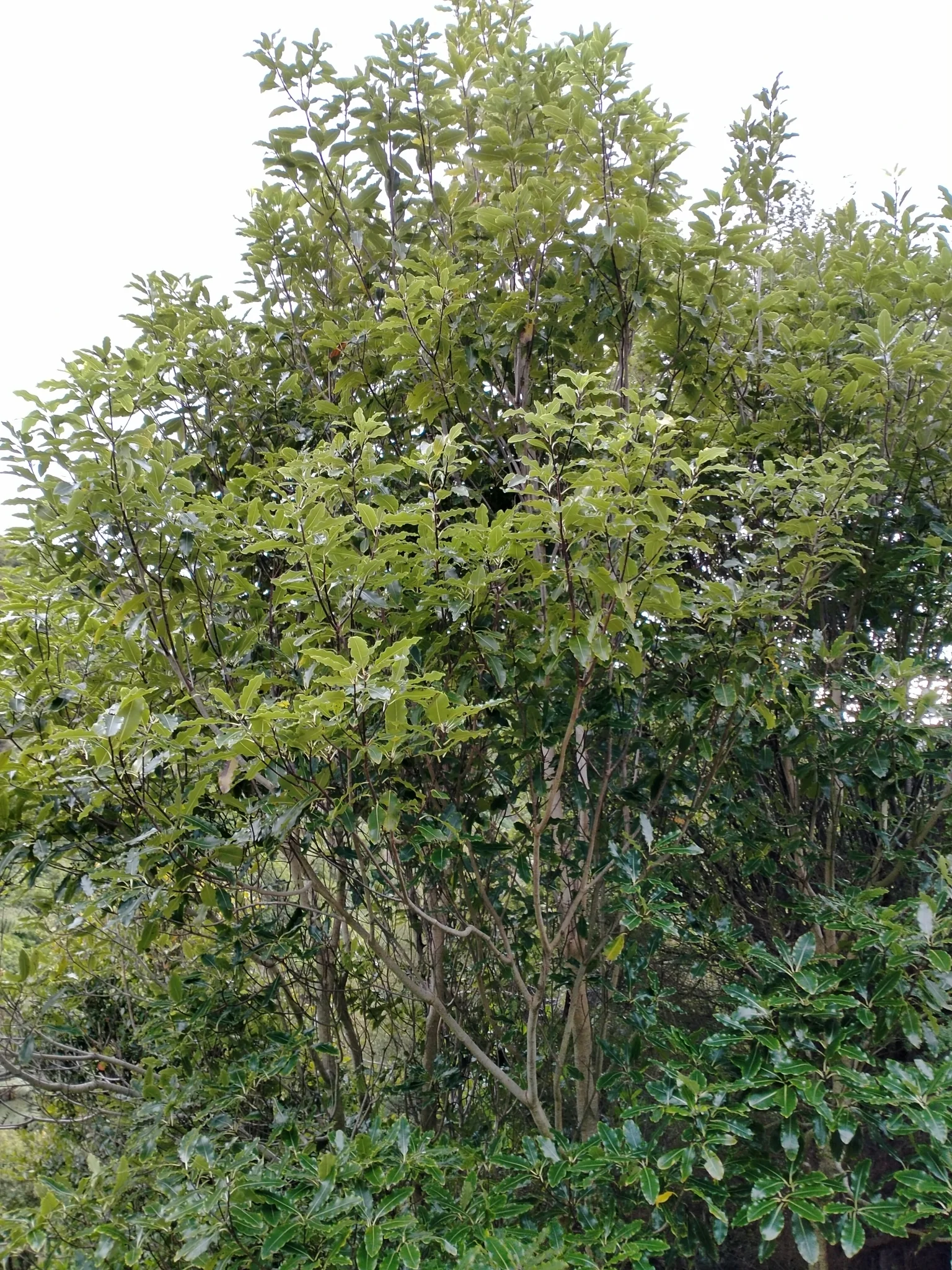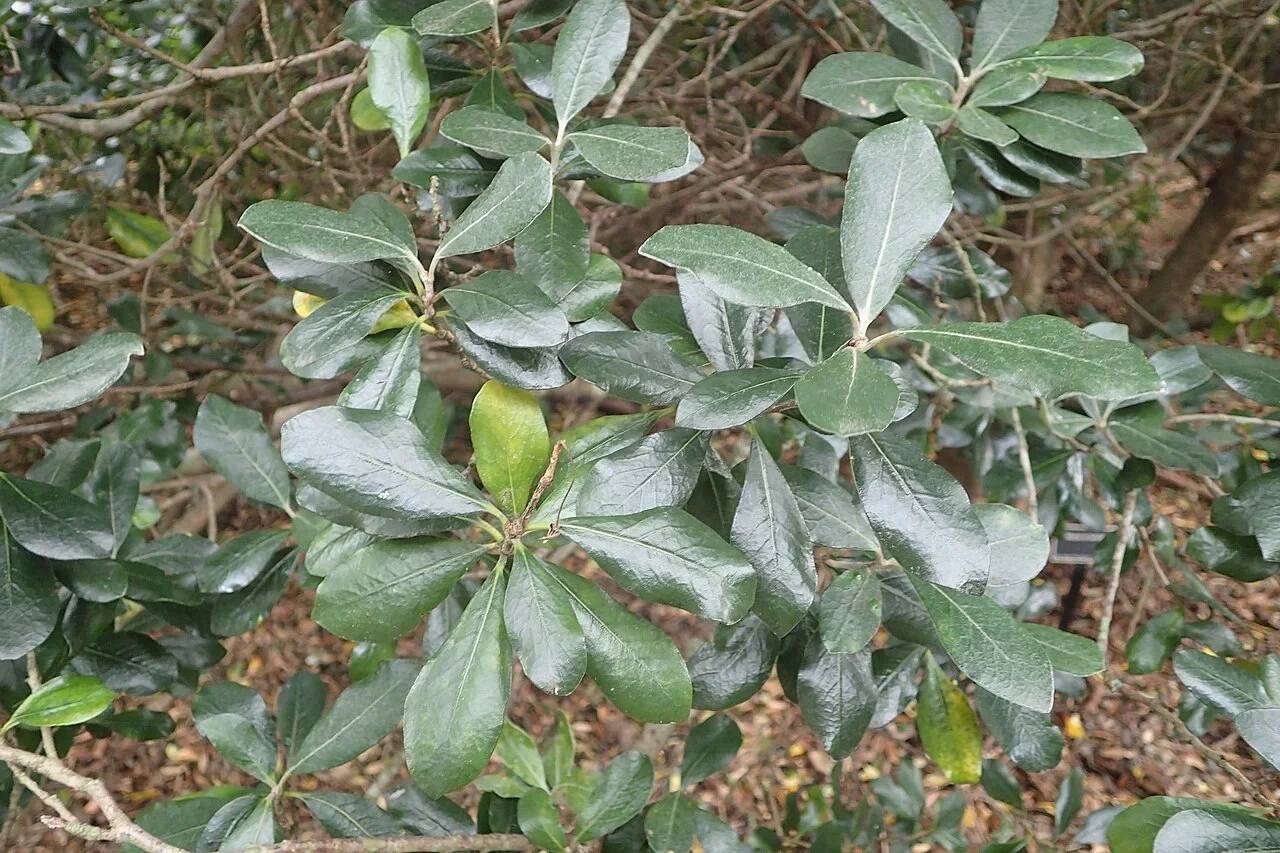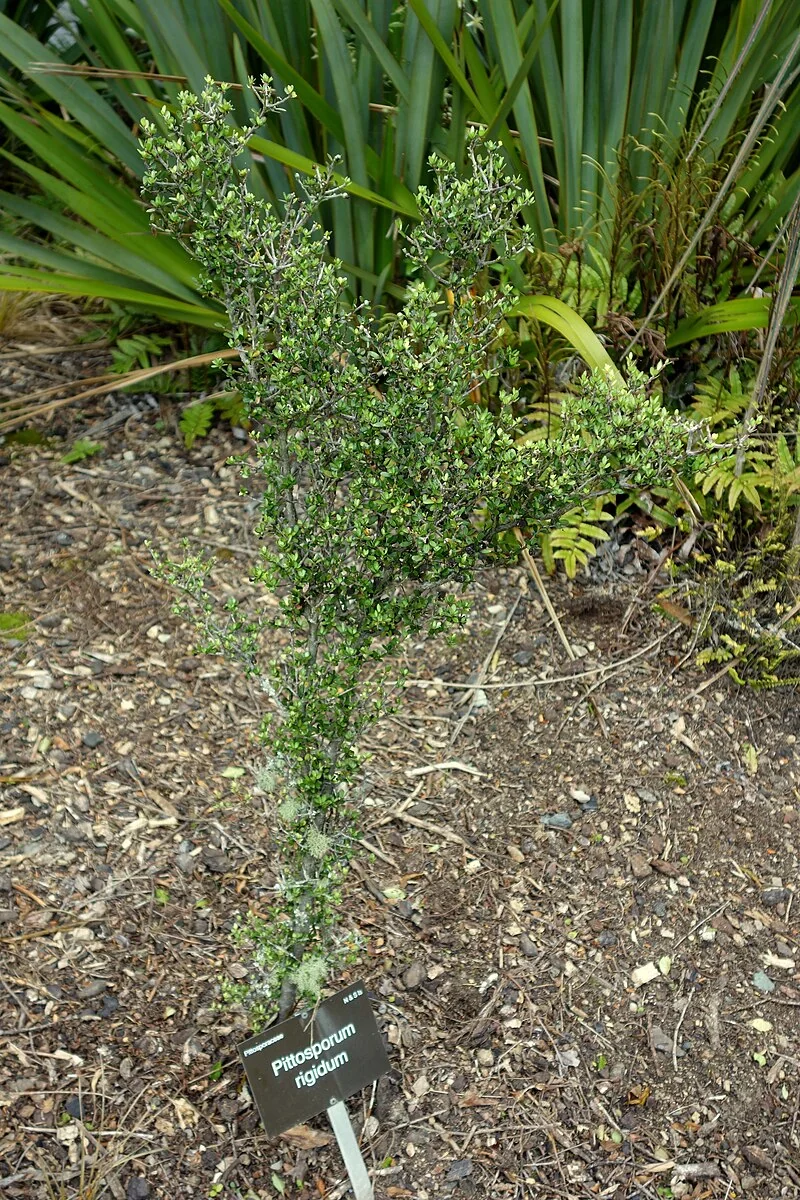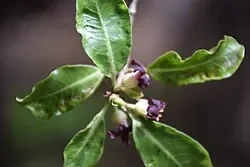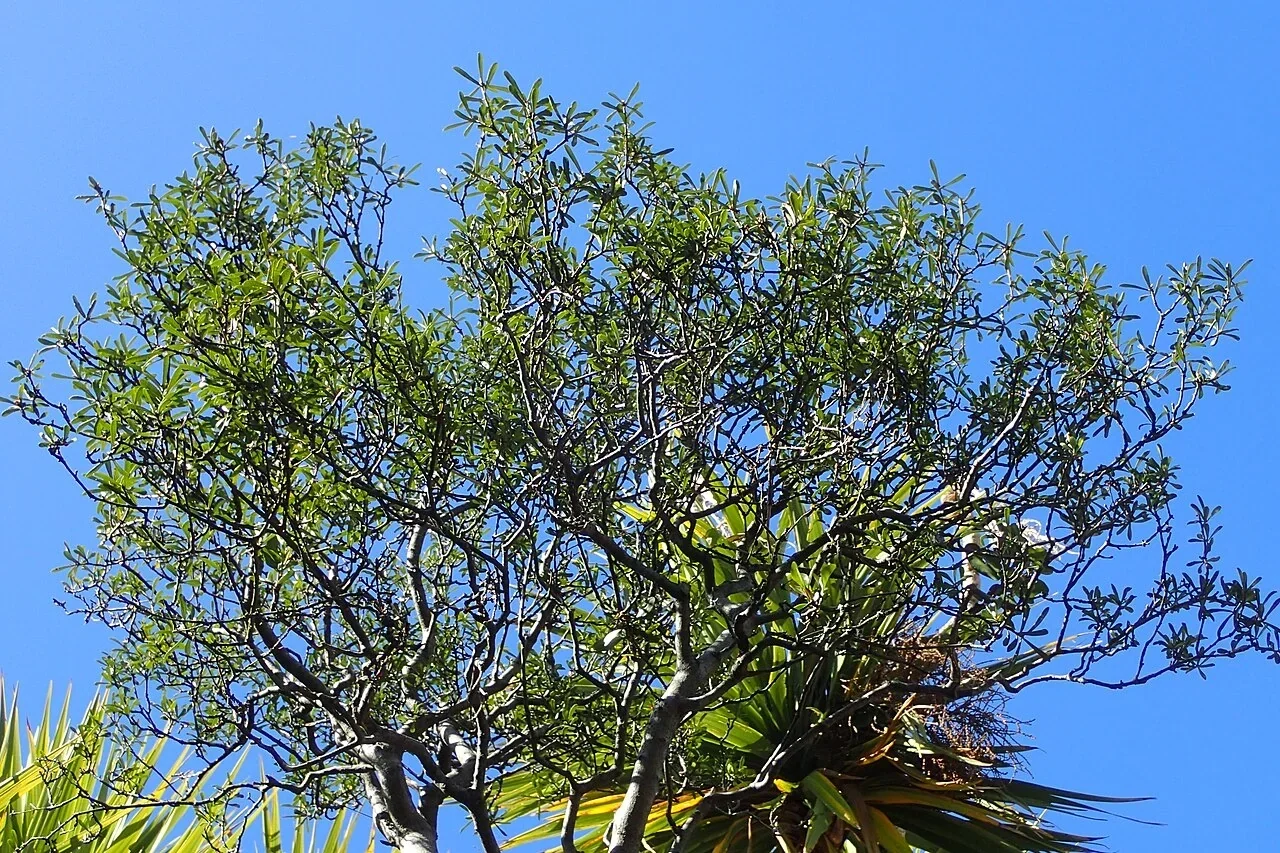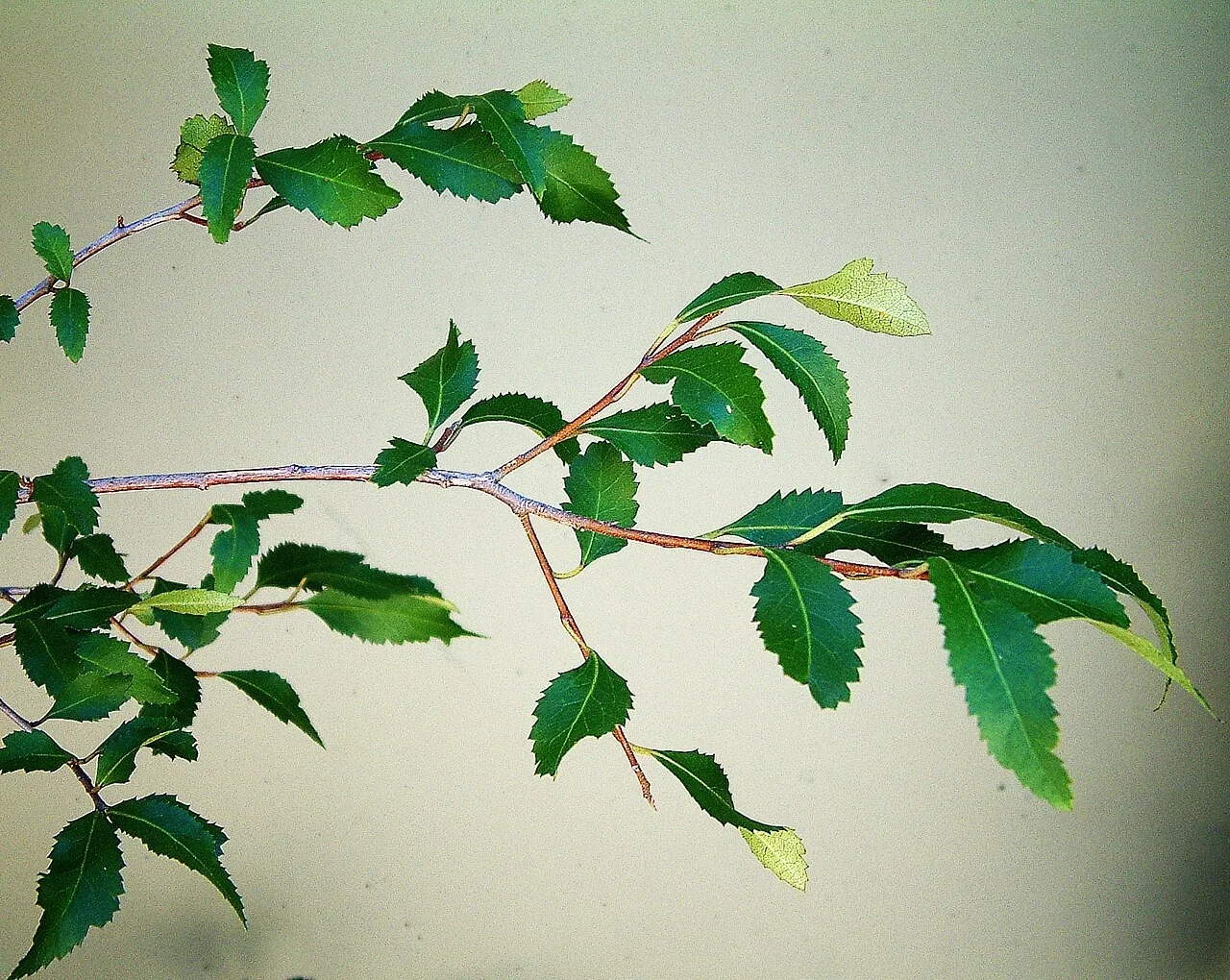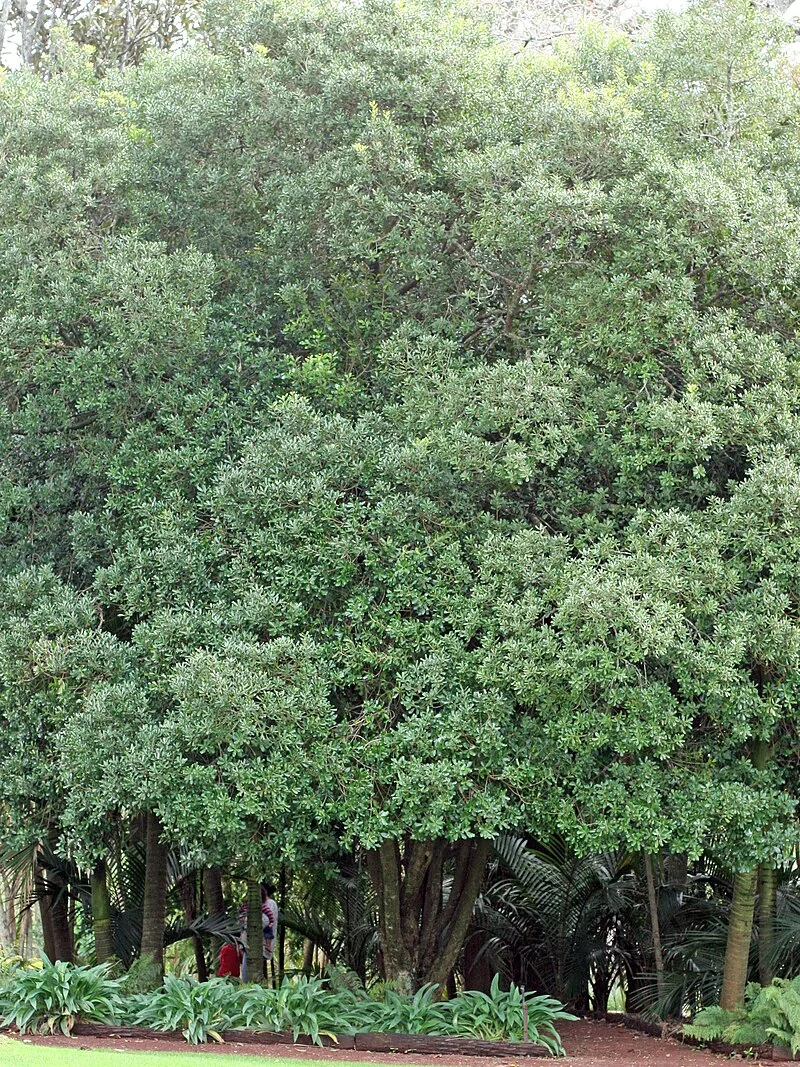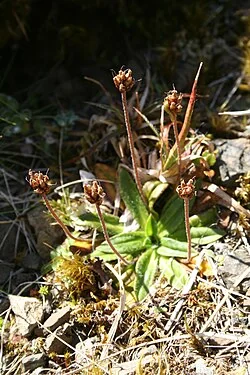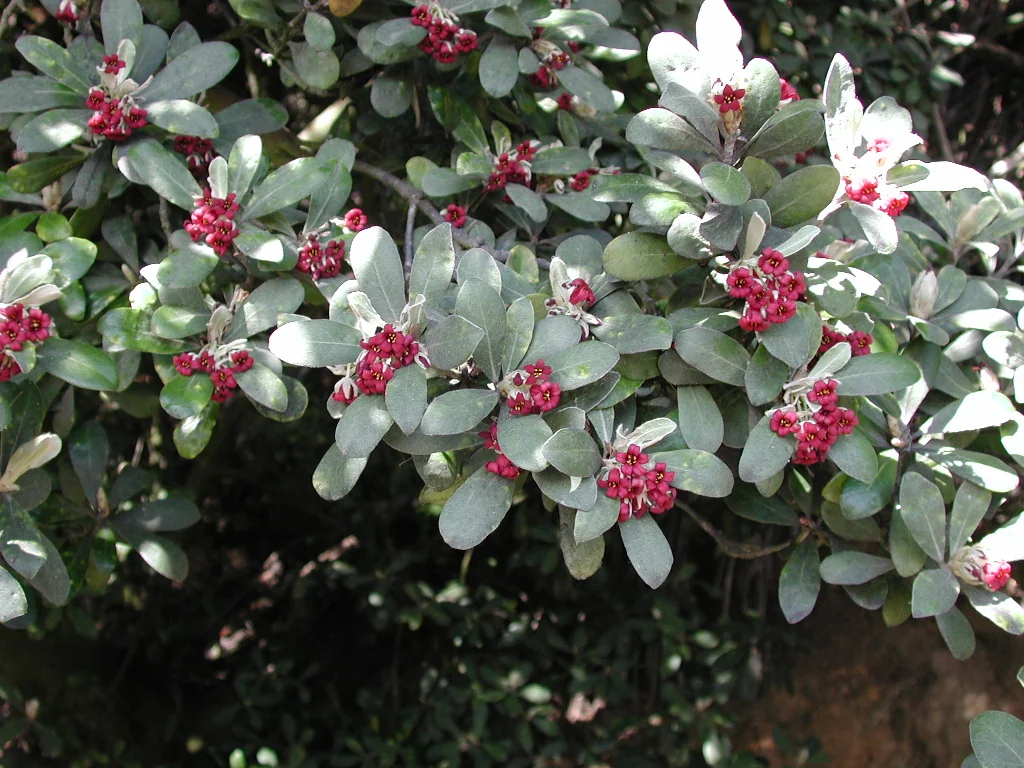
Karo
Pittosporum crassifolium
Karo (scientific name: Pittosporum crassifolium) Karo is a hardy coastal native tree renowned for its thick, leathery grey-green leaves and remarkable tolerance of salt spray and wind. With fragrant crimson to purple flowers in spring and fast growth, it's an exceptional choice for coastal gardens and shelter plantings. Explore more in the native plants index.

Plant Description
Botanical Features
Karo (Pittosporum crassifolium), also known as Stiffleaf Cheesewood, Kaikaro, or Kihikihi, is an evergreen shrub or small tree native to New Zealand. It typically grows to 5-10 meters tall and 3-4 meters wide, with an upright, bushy habit. Its name "crassifolium" is Latin for "thick leaf," referring to its distinctive foliage. The leaves are oval to obovate or oblanceolate, 5-10 cm long and 2-3 cm wide, leathery, dark green on the upper surface, and covered with dense whitish or buff-colored fine hairs (tomentum) on the undersides and petioles. This tomentum helps protect against salt damage and moisture loss in coastal environments. The leaf margins are often recurved and entire. During spring to early summer (August to October), it produces fragrant, squat-campanulate (bell-shaped) flowers. These flowers are typically dark burgundy red to deep red, though rarely white in New Zealand, and are borne in terminal clusters. Following the flowers, hard green capsules develop into seed pods. These capsules are spheroidal or obloid, 15-25 mm long, pale grey-green, and densely tomentose. When ripe, typically in late autumn or September, the capsule splits into three or four woody valves, revealing numerous sticky black seeds embedded in a yellow pith.
Quick Facts
Overview
| Scientific Name | Pittosporum crassifolium |
|---|---|
| Height | 3-10 m |
| Spread | 2-6 m |
| Water Needs | Low to moderate |
| Light | Full sun to partial shade |
| Frost Tolerance | Moderate when mature |
| Salt Tolerance | Excellent |
| Growth Rate | Fast |
| Lifespan | Long-lived |
Climate Best Suited to
Regional climate suitability across major New Zealand cities.
Regional Suitability
| City | Climate Suitability |
|---|---|
| Whangārei | Ideal |
| Auckland | Ideal |
| Hamilton | Ideal |
| Tauranga | Ideal |
| Rotorua | Ideal |
| Gisborne | Ideal |
| New Plymouth | Ideal |
| Napier | Ideal |
| Whanganui | Ideal |
| Palmerston North | Ideal |
| Wellington | Ideal |
| Nelson | Ideal |
| Christchurch | Ideal |
| Dunedin | Ideal |
| Invercargill | Ideal |
Natural Habitat
Karo (Pittosporum crassifolium), also known as Stiffleaf Cheesewood, Kaikaro, or Kihikihi, is an evergreen shrub or small tree endemic to New Zealand. Its natural habitat primarily consists of coastal areas and offshore islands, particularly the Great Barrier and North Islands, extending south to about White Cliffs and East Cape.
Preferred Conditions:
- Coastal Environments: It thrives on steep slopes, cliff faces, boulder beaches, rock stacks, and the margins of petrel-burrowed land, showcasing its exceptional adaptation to harsh coastal conditions.
- Dune Forests and Forest Margins: Karo can also be a significant component of dune forests and is found along forest margins and streams in coastal localities.
- Resilience: This species is remarkably tolerant of high winds, salt spray, drought, and even moderate frosts once established. The fine hairs on the underside of its leaves help reduce salt damage and prevent moisture loss, allowing it to thrive in these challenging environments.
Distribution:
- Endemic to North Island and Offshore Islands: While endemic to the North Island and its offshore islands, due to bird dispersal of its sticky seeds, it has become widely naturalized further south in New Zealand (South, Stewart, and Chatham Islands) and even in Norfolk Island and Hawaii. In these non-endemic areas, it is sometimes considered an urban weed due to its prolific spread.
Karo's ability to colonize and thrive in exposed coastal environments underscores its ecological importance in stabilizing vulnerable areas and providing habitat in challenging conditions.
Plant Conservation
Pittosporum crassifolium, also known as karo, stiffleaf cheesewood, kaikaro, or kihiki, is classified as "Not Threatened" in its native New Zealand. This conservation status has been consistent, with records showing it as "Not Threatened" in 2023, 2017, 2012, 2009, and 2004.
While not threatened in its endemic range, the species is noted to be widely naturalized in other areas, including the South, Stewart, and Chatham Islands of New Zealand, as well as Norfolk Island and Hawaii. In some of these non-native regions, it can be considered an "urban weed" due to its prolific dispersal by birds. It is also regarded as a potential environmental weed in parts of southeastern Australia.
Threats to Pittosporum crassifolium in its native habitat include rats eating its fruits, which can hinder regeneration on rodent-infested offshore islands.
Growing Requirements
Soil Requirements
Karo prefers dry, free-draining soils and is remarkably adaptable to poor coastal conditions. It naturally grows on steep slopes, cliff faces, and boulder beaches, making it excellent for challenging sites where other plants struggle.
- Prefers dry, free-draining soils
- Tolerates sandy, gravelly, and poor soils
- Excellent for coastal and salt-affected conditions
- Avoid waterlogged soils which can cause leaf drop
- Thrives in rocky and steep terrain
Light Requirements
Karo adapts to both full sun and partial shade, with growth habit varying by exposure. In full sun it maintains a compact 3 m height, while in shade it stretches to reach light and can grow up to 6 m tall.
- Full sun preferred for compact, dense growth
- Partial shade tolerated but may become leggy
- Height varies with light exposure (3 m in sun, 6 m in shade)
- Excellent for exposed coastal positions
Water Requirements
Karo has low to moderate water needs and is drought-tolerant once established. Regular watering during establishment helps develop strong roots, but mature plants can withstand dry periods.
- Low to moderate water requirements
- Regular watering needed during establishment
- Drought-tolerant once roots are established
- Avoid overwatering which can weaken the plant
- Natural rainfall often sufficient in most areas
Planting Guide
Karo is a hardy and versatile native New Zealand tree that is relatively easy to grow, making it suitable for various planting scenarios, including hedging, screening, and specimen planting. Its resilience and ecological value make it a rewarding addition to any native garden.
1. Site Selection:
- Sunlight: Karo thrives in full sun to partial shade, ideally receiving at least six hours of direct sunlight daily. Varieties with variegated or purple leaves will maintain their unique color best in full sun.
- Soil Type: It prefers well-drained, loamy soil with a neutral to slightly acidic pH (5-7). It can tolerate a range of soil types, including sandy or clayey soils, as long as there is good drainage to prevent root rot.
- Environmental Tolerances: This plant is highly tolerant of coastal conditions, high winds, and salt spray, making it suitable for tricky situations.
2. Planting Steps:
- Timing: The best time to plant Karo is after autumn rains for best establishment, or in early spring.
- Preparation: Choose healthy, well-grown plants. Before planting, ensure the root ball is saturated. Dig a hole that is twice the diameter and the same depth as the plant's root ball. If the soil is poor, dig it wider and amend with compost or soil amendment.
- Planting: Carefully remove the plant from its container with minimal root disturbance. Trim any broken roots. Place the plant in the hole, ensuring the top of the root ball is level with the surrounding soil. Fill the hole with soil, gently firming it around the base.
- Watering: Water thoroughly immediately after planting to settle the soil and remove air pockets. Continue to water well until established, especially during dry periods.
- Mulching: Apply a layer of mulch around the base to retain moisture and suppress weeds, keeping the mulch away from the plant stems.
3. Care Instructions:
- Watering: Once established, Karo is drought-tolerant, but regular watering is crucial during the first growing season to develop a strong root system. Water deeply once a week during dry periods, allowing the soil to dry out slightly between waterings.
- Fertilizing: Young plants benefit from extra phosphorus to encourage root development. Established plants can benefit from a balanced, slow-release fertilizer each spring. Avoid fertilizing late in the growing season.
- Pruning: Regular pruning helps maintain shape and encourages healthy growth. Prune in late winter or early spring before new growth begins. Use clean, sharp shears to remove dead, damaged, or crossing branches. For hedges, shear off the top 2-6 inches several times during the first two seasons to promote branching.
- Pests and Diseases: Karo is relatively pest-resistant but can occasionally attract scale insects and aphids. Root rot can occur in poorly drained soils.
Ecological Role
Coastal Resource
Karo (Pittosporum crassifolium) is a key coastal shrub-small tree, its nectar-rich, dark flowers attracting nocturnal moths and other insects. Birds feed on the sticky black seeds exposed when the capsules split, helping disperse the species along shorelines and cliffs.
Habitat Services
Dense canopies provide wind shelter and nesting cover in exposed coastal scrub. Leaf litter contributes organic matter to sandy, free-draining soils.
Uses and Significance
Karo provides important habitat and food sources for native and introduced birds. The fragrant spring flowers attract pollinators, while the seeds are widely distributed by birds, often appearing spontaneously in gardens. The dense foliage offers excellent nesting sites.
Cultural and Traditional Significance
The name "crassifolium" means "thick leaf" in Latin, referring to its distinctive leathery foliage. Karo has been an important coastal species for both Māori and European settlers, valued for its hardy nature and ability to provide shelter in harsh coastal conditions.
- Named for its distinctive thick, leathery leaves
- Traditional importance in coastal settlements for shelter
- Historical use as indicator of coastal growing conditions
- Cultural significance in New Zealand's maritime heritage
Landscape and Garden Uses
Karo is exceptional for coastal gardens, shelter belts, and challenging sites. Its fast growth, salt tolerance, and attractive appearance make it ideal for hedging, screening, and structural plantings in both formal and informal landscapes.
- Outstanding coastal hedge and shelter plant
- Excellent windbreak and privacy screening
- Perfect for steep slopes and erosion control
- Low-maintenance specimen tree for coastal gardens
- Ideal for difficult sites where other plants fail
- Fast-growing background plant for mixed borders
- Structural element in native and Mediterranean-style gardens
Landscaping Ideas
Coastal Shelter and Screening
Karo's dense, salt-tolerant foliage makes an excellent wind filter and privacy screen on exposed coasts. Clip lightly after flowering for compact form; combine with Coprosma repens and Myoporum laetum for layered shelter.
Seasonal Care Calendar
Spring
Spring is the optimal planting season for Karo and brings the spectacular flowering period (August-October) with richly scented crimson to purple flowers. This is also the time for annual pruning and establishment care.
- Peak flowering season with fragrant crimson-purple blooms
- Ideal planting time for establishment before summer
- Annual pruning to maintain shape and density
- Begin regular watering for new plantings
- Take semi-hardwood cuttings for propagation
Summer
Summer requires attention to watering for newly planted trees, though established plants are very drought-tolerant. This is when the green seed capsules begin to develop from the spring flowers.
- Monitor water needs for newly planted trees
- Seed capsule development begins
- Continue taking semi-hardwood cuttings
- Light pruning to maintain shape if needed
- Generally very low maintenance period
Autumn
Autumn is another excellent planting season and the time for final pruning. Seed capsules ripen and split open to reveal black seeds, with the orange-colored capsule interiors adding ornamental interest.
- Second optimal planting season
- Seed capsules ripen and split (September onward)
- Final pruning of the year to prevent legginess
- Collect seeds for propagation if desired
- Reduce watering as growth slows
Winter
Winter is the rest period for Karo, though established plants are frost-tolerant. Young plants may need protection from severe frosts, but mature trees handle moderate frosts and even snowfall well.
- Minimal care required for established plants
- Protect young plants from severe frosts
- No watering needed except in very dry conditions
- Good time for planning garden improvements
- Watch for natural seed germination in garden
Pruning and Maintenance
Techniques and Timing
Karo responds excellently to pruning and benefits from annual trimming to maintain optimal health and appearance. Regular pruning promotes dense growth and prevents the plant from becoming leggy, especially important for hedging applications.
- Annual pruning essential for optimal growth and health
- Prune back to leaf nodes for best results
- Trim tops in late summer/autumn to prevent legginess
- For hedging: regular trimming promotes dense growth
- Remove dead, damaged, or crossing branches as needed
- Responds well to hard pruning if renovation needed
- Sterilize tools to prevent disease spread
How to Grow Karo
Karo is a hardy coastal native tree renowned for its thick, leathery grey-green leaves and remarkable tolerance of salt spray and wind. With fragrant crimson to purple flowers in spring and fast growth, it's an exceptional choice for coastal gardens and shelter plantings. Understanding its propagation methods is key to successfully growing this delightful species.
From Seed (Easiest Method)
Propagating Karo from fresh seed is a very easy and effective method, often resulting in spontaneous seedlings appearing in gardens as birds distribute the seeds widely. The ripe capsules split open in autumn to reveal black seeds ready for collection. Collect seeds when capsules split open (September-autumn). Remove seeds from orange-lined capsules. Sow fresh seeds immediately in a well-draining seed-raising mix. Keep soil consistently moist and provide bright light. Germination is typically reliable and fairly quick. Transplant seedlings when large enough to handle. Watch for natural seedlings appearing around mature plants.
From Semi-Hardwood Cuttings
Semi-hardwood cuttings taken in late summer to early autumn provide a reliable method to propagate known characteristics and maintain specific growth forms. Take 10-15cm cuttings from current season's growth. Select semi-hardwood material in late summer/early autumn. Remove lower leaves, keeping top leaves. Dip in rooting hormone for better success rates. Plant in well-draining propagation mix. Provide a humid environment and bright, indirect light. Roots typically develop within 6-10 weeks. Transplant when a well-rooted system is established.
Pests and Diseases
Karo (Pittosporum crassifolium) is very tolerant of salt and wind. In dense shade it can get lanky - a late-winter heading cut encourages bushier growth. Watch for sooty mould under perches where birds feed on sticky seeds; a gentle hose-down restores leaf sheen.
Cultural Significance
Pittosporum crassifolium, commonly known as Karo, holds significant cultural importance, particularly for the Māori people of New Zealand, where it is native.
Key Aspects of Its Cultural Significance Include:
- Traditional Māori Uses: The Māori have historically utilized Karo for practical purposes, including crafting tools, weapons, and musical instruments. Its dense and durable wood was also valued for carving and construction. The wood and leaves were also used for medicinal purposes.
- Symbolism: The fragrant flowers of Karo are associated with love and romance. More broadly, the plant symbolizes resilience and protection due to its ability to thrive in harsh coastal environments. Its tough leaves and hardy nature represent endurance and safeguarding, embodying the strength and perseverance of the Māori people.
- Spiritual Value: Beyond its practical applications, Karo is cherished in Māori culture for its spiritual significance.
- Metaphorical Representation: The plant's resilience has led to its use as a metaphor for enduring difficult circumstances in literature and art. It is also incorporated into special events that celebrate strength and milestones, and as a symbolic gift for housewarmings, representing a safe and resilient home.
Additionally, Pittosporum crassifolium Has Other Uses:
- A dark blue dye can be extracted from its seeds.
- It is a source of saponins, which have been used as soap and as a bird deterrent.
- Its tough wood is also used for inlay.
- Due to its tolerance to pruning and maritime exposure, it is often used for protective hedges and for stabilizing sandy soils and dunes.
Bonus Tip
Karo is incredibly resilient, tolerating high winds, salt spray, and drought. Its leaves have fine hairs on the underside to protect against salt damage and moisture loss. Birds avidly eat and widely disperse its sticky seeds.
